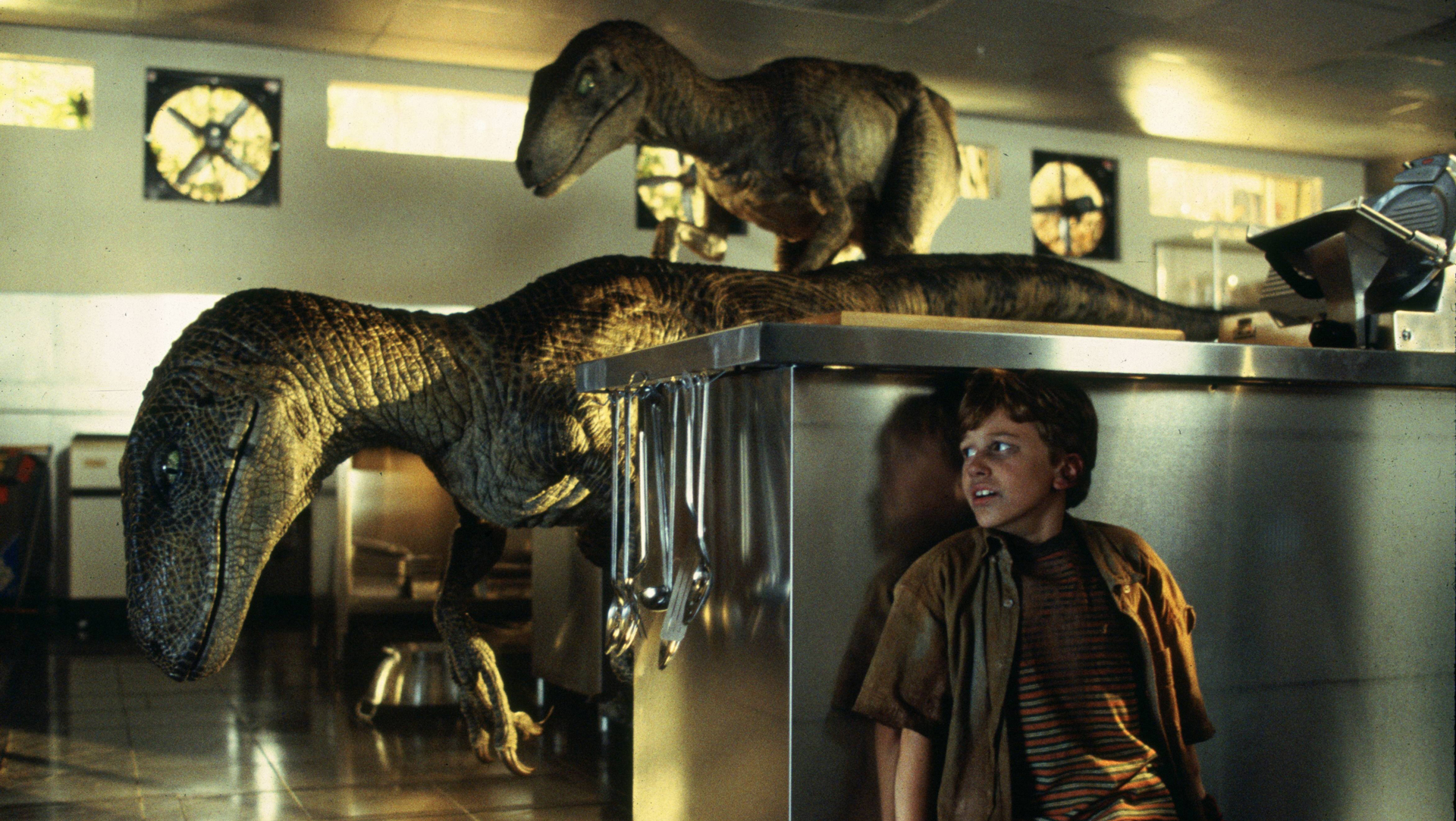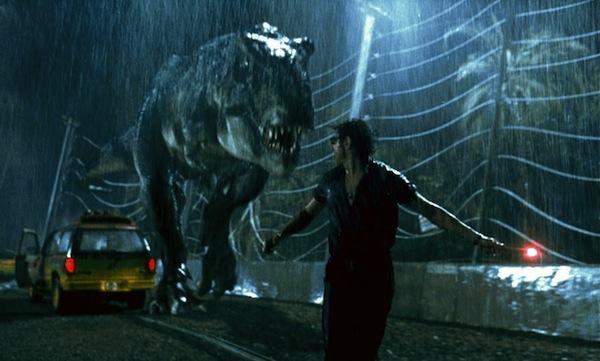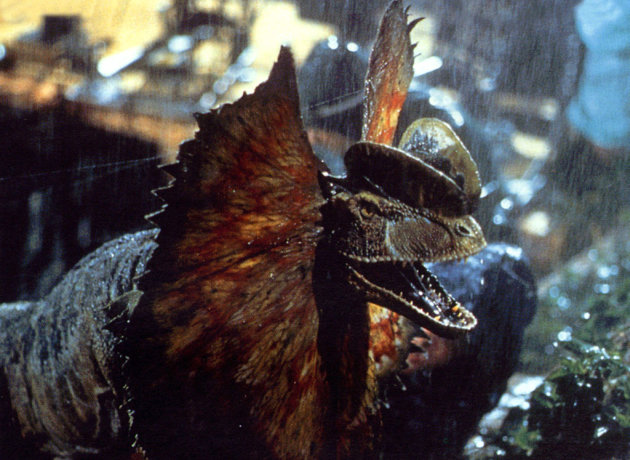Hello, everyone! I think that it’s about time to go through Jurassic Park and explain what’s real science and what’s completely fictional. In order to do this, I have decided to sit down and watch the movie for what is probably around the hundredth time, so the following will be in chronological movie order.
- · You can find “dinosaur age” amber in the Dominican Republic: Fiction.
There is actually quite a bit of very good amber that comes from the Dominican Republic, and it does frequently have fossil inclusions of leaves and insects, but it is only about 15-40 million years old. This is well after the end of the Mesozoic Era and the extinction of all non-avian dinosaurs. - · At a dinosaur excavation, the bones will be a perfect skeleton under just a thin layer of soft dirt that can be brushed away easily: Fiction.
Dinosaurs are usually found disarticulated, which means that the bones are not put together in a recognizable body but are strewn around in a relatively small area. This is because, when an animal dies, the body is usually torn apart by scavengers or the individual bones get separated in the river current in which they are being deposited. Fossilization is a very rare event; most bones are simply broken down and reused by plants and fungi. Often, not all of the bones are even present — just a few here and there. Sometimes, you get lucky and do find an entire articulated skeleton, but they are much rarer. Even then, they are hard to get at and take a lot of work. - · You can shoot a radar pulse into the ground to have a computer locate dinosaur bones for you: Fiction.
I’ve heard a rumor that someone is working on making this technology work right, but it is not currently being used. For most skeletons that are found, we dig them up because a piece of them were sticking out of the ground. We use erosion to locate dinosaur skeletons; this is why we usually work out in the desert or other areas where erosion is occurring. The only occasion I am aware of in which someone used technology to locate a buried skeleton was in one area where the fossil bones contained radioactive minerals, and so they traced the radiation and dug up the skeleton. - · [Talking about the skeleton] “Velociraptor? Yes, good shape too. I’m guessing about five-six feet high, nine feet long…” – Dr. Grant: Fiction.
In the book on which the movie is based, Michael Crichton explains that the skeleton being dug up here in Montana is a Velociraptor antirrhopus. He based this on an article in a journal that had incorrectly classified Deinonychus antirrhopus as a species of Velociraptor. The only recognized species of Velociraptor today is mongoliensis. It lived in what is now China and Mongolia, and it was roughly the size of a turkey. Oddly enough, Crichton later specifies that the dinosaurs in the park were mongoliensis and not antirrhopus, so they were too large regardless. - · “Well, maybe dinosaurs had more in common with present day birds than they do with reptiles. Look at the pubic bone, turned backward just like a bird, look at the vertebrae, full of air sacs and hollows just like a bird…” – Dr. Grant: Fact.
- · “…and even the word ‘raptor’ means ‘bird of prey’” – Dr. Grant: Fiction.

The infamous kitchen scene
“Raptor” means thief. Birds of prey are also known as raptors, but this is because they are also being described as “thieves.’
- · “…visual acuity is based on motion, like T. rex…” – Dr. Grant: Fiction.
There is no evidence whatsoever that T. rex could only see things if they were moving. - · “Velociraptor is a pack hunter” – Dr. Grant: Plausible.
There is evidence of “mobbing,” at the very least, in which multiple raptors would all attack the same prey at the same time, but there is no direct evidence of coordinated pack hunting. It might have happened, but it’s unclear whether it did. - · “And he slashes at you with this six inch retractable claw, like a razor…”
There have been studies that showed that the “sickle claw” was not very good at slashing, but instead, the entire foot seemed to be built for gripping. My previous post explains how raptors may have hunted using this sickle claw. - · Neither fact nor fiction but a moment of brilliant foreshadowing: as the helicopter prepares to land, things get a little bit bumpy and people scramble for seatbelts. Dr. Grant finds he is stuck with two female seat belt halves, but he finds a way and ties them together.
- · “Ellie, we can tear up the rule book on cold-bloodedness. It doesn’t apply, they’re totally wrong! This is a warm-blooded creature!” – Dr. Grant: Plausible.
I will discuss this topic further in a later post. -

T. rex chasing Dr. Ian Malcolm (Jeff Goldblum)
· “We clocked the T. rex at 32 miles per hour.” – Mr. Hammond: Fiction.
Recent work has shown that the T. rex could run at a max speed of about 18 mph, just faster than a professional soccer player. - · “They’re moving in herds. They do move in herds.” – Dr. Grant: Fact.
We have fossilized footprints of groups of herbivores moving all in the same direction, likely indicating a herd migration or something similar. - · It is possible to extract meaningful genetic information from the blood of a mosquito that fed on a dinosaur: Fiction.
It was recently discovered that the half-life of DNA is 521 years. This means that usable DNA only lasts for about one million years at the upper limit. Aside from this, the mosquito is actively breaking down the blood in its digestive tract, further reducing the chances of finding usable DNA. Protein fragments and DNA from dinosaurs have been found, but the genetic material is in individual bases rather than an ordered code. - · “We use the complete DNA of a frog to fill in the holes and complete the code. And now, we can make a baby dinosaur” – DNA video: Fiction.
Hypothetically, one could fill in gaps in a DNA code with modern DNA from another animal. The problems here are that there is no good usable source of DNA and the frog is a terrible choice for filling in the gaps. Birds are much more closely related to any of the dinosaurs that they resurrected than frogs are. - · “They imprint on the first creature they come into contact with” – Mr. Hammond: Plausible.
This does happen with some birds, but there’s no way to know if it was true in other dinosaurs. - · [Talking about the Velociraptors] “Cheetah speed. Fifty, sixty miles per hour if they ever got out in the open. And they’re astonishing jumpers…”: – Mr. Muldoon: Fiction.
Velociraptor and Deinonychus were actually not the strongest runners. As discussed in my previous post, they hunt by ambushing and gripping on to their prey, so their feet are very strong, but their legs are not adapted to be particularly fast. - · “They show extreme intelligence, even problem solving. Especially the big one. We bred eight originally, but when she came in, she took over the pride and killed all but two of the others. That one — when she looks at you, you can see she’s thinking (or) working things out. She’s the reason we have to feed ’em like this. She had them all attacking the fences when the feeders came.”
“The fences are electrified, right?”
“That’s right. But they never attack the same place twice. They were testing the fences for weaknesses. Systematically. They remembered.” – Mr. Muldoon: Fiction.
Raptors are very closely related to birds and are some of the smartest non-avian dinosaurs to have existed. They were close to being the smartest animals alive at the time that they lived. They were not as smart as depicted in the movie. Their likely intelligence levels have been compared variably to opossums and to ostriches. Could they open doors? Maybe. Could they hunt in packs? Possibly. Could they systematically test an electric fence in order to break out? Probably not. - · “Well, the question is, how can you know anything about an extinct ecosystem? And therefore, how could you ever assume that you could control it?”: Fact.
This is important. There is a lot of talk about cloning a woolly mammoth. Even if they succeed, this only brings back the biology, not the behavior. Almost all behaviors are learned, and without authentic parents, there is no way to bring back authentic behaviors. A cloned mammoth would learn from its surrogate parents, be they elephants or humans, and would have to develop a whole new set of behaviors if it were released into the wild or into a realistic ecosystem. - · “Dilophosaurus is actually poisonous”: Fiction.

Dilophosaurus with the imaginary frill around its neck
There is currently no accepted evidence of any dinosaur being poisonous, nor is there any evidence of an erectable frill.
- · T. rex appearance: Plausible, mostly.
T. rex may or may not have had dinofuzz. We have no idea what sound it made — the sounds in the movie are an amalgamation of various modern animals. Its vision was almost certainly not based on movement. It could run only a little faster than a human, and therefore, any motor vehicle and possibly even a bicycle would be enough to outrun it. Hopefully. T. rex did have a sense of smell on par with that of a turkey vulture, the most sensitive sense of smell in the modern animal kingdom. - · Tyrannosaurus can run straight through a solid tree branch with no damage to itself: Fiction.
- · Brachiosaurus sings to others of its kind: Fiction.
There is no evidence of which I am aware that points to sauropods singing. Sauropods had exceptionally small brains for their size, so I suspect that the amount of audible communication was minimal. - · Brachiosaurus appearance: could be better.
This is probably about as high up as a sauropod could lift its head without either fainting or breaking its neck.
Due to the shape of the neck vertebrae and the phenomenal blood pressure required to stay conscious and get enough blood to a head held up that high, it is more likely that sauropods, like Brachiosaurus, held their long necks out at a much flatter angle very unlike a giraffe. Also, in the scene where Dr. Grant and the kids are petting the Brachiosaurus while they are in the tree, the animal’s head is far too big. It is depicted with a head about the size of Dr. Grant when a real sauropod’s head is not much larger than a football in order to stay light at the end of such a long neck. The animal is also shown chewing up the leaves that Dr. Grant fed it, but sauropods do not chew their food.
- · “Some South African frogs have been known to change from male to female in a single sex environment.”: Complicated.
It is true that there are animals that change genders when necessary. However, it has always seemed to me that the necessity for the gender-switching plot device was a little hard to swallow. There is actually an entirely scientifically plausible method of getting around the entirely female population. The answer is called “parthenogenesis.”
Parthenogenesis occurs when the DNA of an unfertilized egg doubles and the cell develops as though it were fertilized. Birds have different sex chromosomes than mammals do. While mammals have XX (female) and XY (male), birds and some other reptiles have ZZ (male) and ZW (female). WW is inviable. Because of this, if a female bird undergoes parthenogenesis, when the DNA doubles, the only viable eggs will be ZZ (male). The population can then reproduce normally, albeit with an inbred gene pool. This behavior has actually been observed in komodo dragons where a female stranded on an island will generate a new population by mating with her sons. - · Velociraptor appearance: some right, some wrong, all awesome.
As mentioned earlier, there are a few things wrong with Velociraptor as it is portrayed in the film. It should have been covered in feathers, was about the size of a turkey and was probably not as smart as the movie implies. They were, however, quite intelligent for their environment and may have hunted in packs in ambushes by prey-riding.
That’s about it. If there’s interest, I might go through the other two movies at some point although they are much worse movies. Hope you enjoyed it!
If you missed my first post or any of the others, check out Meet the Paleontologist!

2 Comments
Pingback: Jurassic Park (Novel) Criticism | LJS Blog
Pingback: Jurassic Park (Novel) Criticism | LJS Blog